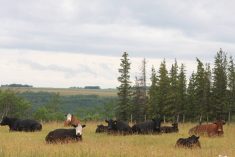The saying about wanting to have your cake and eat it too has always annoyed me. Why would I have a piece of cake if not to eat it? And in order to eat the cake, I must first have it.
But shake up the sentence structure, and the saying suddenly makes sense (at least to me): You can’t eat your cake and have it, too. In my opinion, it’s a better representation of unrealistic expectations.
I’m not alone in this preference. Ben Zimmer writes in the New York Times that the Oxford Dictionary of Proverbs traces that saying back to 1546. “Wolde ye bothe eate your cake, and haue your cake?” That quote is attributed to English playwright John Heywood.
Read Also

Improving soil health on the ranch
Yamily Zavala, PhD, talks soil health for farmers and ranchers at a grazing club field day at Paradise Hill, Saskatchewan.
That old proverb popped into my head as I was reading an ag policy piece written by Al Mussell, Douglas Hedley and Ted Bilyea of Agri-Food Economic Systems (Priorities for Agricultural Policy in a Precarious Time). Specifically, this paragraph:
“The challenge, or contradiction, facing Canada is to move forward with progressive climate change policy, given a popular mandate, but to protect producers helping to advance this objective from lower priced imports that do not carry the same environmental standards — and yet carry on its work with other countries attempting to revitalize the WTO.”
Is that a case of trying to have one’s cake and eat it (a reasonable goal, in my view), or planning to eat one’s cake, yet still have it? Or will sticking strictly to the old rules-based trade playbook mean we don’t get any cake at all?
It’s been a wild year for international trade. Japan has been a bright spot for Canadian beef exports, but so much seems uncertain. The USMCA (also known as CUSMA) hasn’t been ratified. China slammed the door on many Canadian ag exports this year, only recently welcoming back Canadian beef and pork (presumably because freezer stocks are running low). But the door’s still closed to canola (or at least it was when I wrote this in late November).
The Comprehensive Economic and Trade Agreement (CETA) has been disappointing for Canadian ag exporters. Canadian beef and veal exports to the EU are up this year, thanks mainly to the U.K.’s appetite for Canadian beef, but exports to the rest of the EU are tepid and Canada is importing nearly four times as much beef and veal from the EU as we’re exporting to the bloc.
Robert Arnason, reporter with the Western Producer, writes that many in the EU see Canadian agriculture as “backwards and risky.” Monique Iborra, a National Assembly member, told a French radio station that CETA’s goal is to impose EU sanitary and environmental norms on Canada. There’s a strong argument that this is wrong-headed, but to me it sounds quite similar to the challenge/contradiction that Mussell, Hedley and Bilyea outlined in their paper.
However, Canada does not have the market power of the EU or China. Nor are we the U.S., which has been increasing support to its farmers recently. Mussell et al. note that support is likely to depress prices further, and lead to even more support.
“Canada likely has no choice but to protect its producers and follow suit with the U.S. — but with far fewer fiscal resources. Canada is perhaps uniquely vulnerable, with a narrower set of farm products produced impacted by the support programs of others and a relatively large exposure to exports.” The report’s authors see a necessity to plan a response to U.S. ad hoc support, but differentiate such programs from the regular business risk management programs.
The report’s authors do see Canada having a couple of advantages. The one I was most interested in is the potential for Canada to deliver “products with specific attributes that people want on a global basis,” such as sustainable or healthy qualities. Canada’s inspection, grading and data collection systems could be used to shift to a “food to spec” system that consumers are seeking. In other words, we could work harder to give the people more of the cake (or beef) that they want.
This is addressed in the National Beef Strategy. One of the strategy’s marketing objectives is to “get the right product to the right customer every time.” To do that, the Canadian Beef Advisors, who authored the strategy, recommend developing new products and improving carcass utilization and value. They also recommend procuring market intelligence, and then directing efforts and resources towards priority markets.
On the market access front, the strategy is calling for a bi-lateral trade agreement with China to eliminate tariffs, and vigilance against mandatory country-of-origin labelling (mCOOL) in the U.S. As for CETA, the strategy suggests using Verified Beef Production Plus to certify EU-eligible cattle and establishing a mature cattle protocol. It also calls for better communication to producers on EU export protocols, and securing approval from the EU for citric acid, peroxyacetic acid and blends for beef production. There are also several other suggestions for reducing restrictions and tariffs in other markets and improving our own export capacity.
Despite all this uncertainty, it’s worth noting that Canadian beef exports have not been a wash this year. Overall, our exports of beef and veal were up 12 per cent at the end of September, compared to the same time last year. There are a few more export numbers in the News Roundup section of this issue.
I don’t want to guess how this is all going to play out. I don’t envy those in the industry who have to respond to the changing trade climate. They must be nimble without being rash, and focused without developing tunnel vision. They’ll need to figure out whether a goal is reasonable, or whether it’s a case of wanting the cake that’s already been eaten.
















